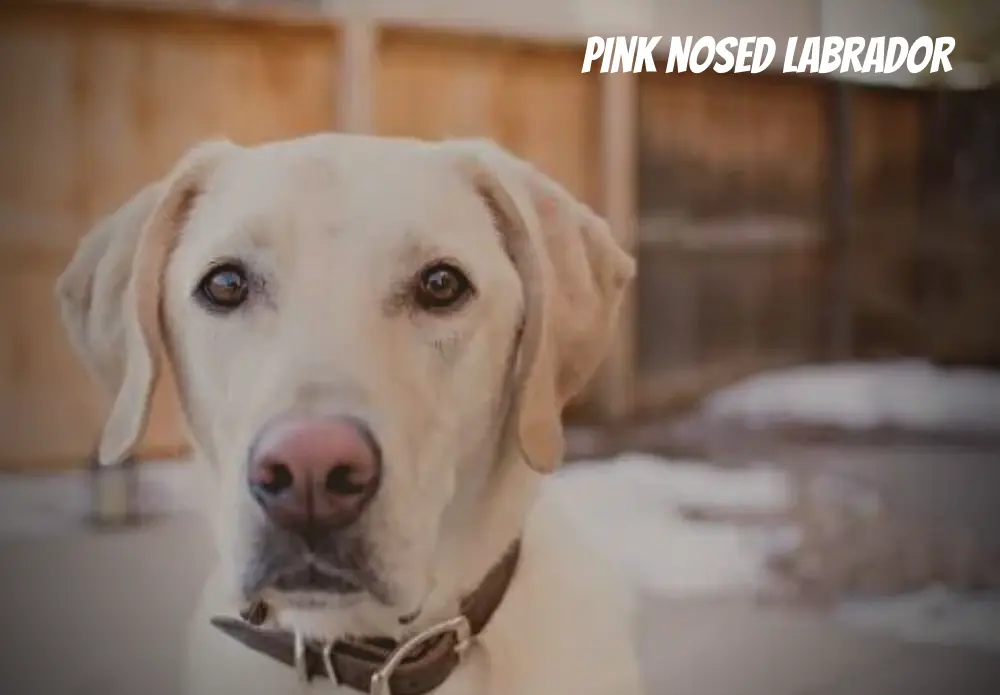If you own a Labrador or are contemplating getting one, you’ve probably heard of a Dudley Labrador.
There is a lot of mystery around these exceptional puppies, which means they may struggle to find a home, or your breeder may charge a premium for the pup.
The name “Dudley” is taken from the British town of Dudley, which produced pink-nosed Bulldogs. It is now used to describe all canines with different nose colors.
This post will explain why Dudley Labs are so special and what differentiates them from other Labradors. It can also help you decide if they are the right dog for you.
What is a Dudley Labrador?
A Labrador Retriever with pigmentation abnormalities on his snout, muzzle, paw pads, and eye rims is known as a Dudley Lab.
There are three hues for Labrador Retrievers: black, chocolate, and yellow. This genetic trait is exclusive to Yellow Labs. However, not all Dudleys and not all Yellow Labradors have pink noses.
Some Yellow Labs’ noses turn pink as they age, leading to common confusion with Dudley Labradors. Tyrosinase, the enzyme responsible for making melanin, loses its efficiency as it ages, which results in depigmentation in dogs.
Siberian Huskies and Golden Retrievers are also susceptible to it. Conversely, Dudleys are born without pigmentation and remain without it for the rest of their lives.
They behave like other puppies of their breed in that they are friendly and outgoing. Their outward look is the only thing that sets them apart. They are wonderful family pets and loyal companions, always by your side.
They are unable to participate in show rings, though. The American Kennel Club specifies that a pink nose in Labradors is grounds for disqualification in its breed standard.
Labrador Pigmentation Genetics
Due to their noses, several people mistake Dudleys for mixed breeds. However, Du[dley Labs are Labrador Retrievers, the offspring of two purebred Labradors. Their pink noses are rare and natural and cannot be considered a genetic anomaly.
The density and kind of melanin in the dog’s body cells define the color of the dog’s coat, skin, and eyes. Natural skin pigment known as melanin is produced by particular skin cells known as melanocytes. Tyrosinase, an enzyme, manages its synthesis.
The genes a puppy receives from its parents determine whether this pigment is present in the cells that make up its nose. Two genetic loci in each Labrador Retriever influence the expression of pigment. They choose whether a dog will be yellow, chocolate, or black.
The first is referred to as the B (brown) locus, which determines the hue of the dark pigment eumelanin. BB, Bb, and Bb are three different forms of the B locus.
Due to the dominant nature of black pigmentation, dogs with the BB or Bb genotype will express black eumelanin. The extension (E) trait is located at the second genetic locus.
This determines whether the eumelanin pigments will express themselves in the fur or only in the skin. The extension allele has three genotypes: EE, Ee, and Ee.
A dog’s B locus will determine the color of its fur if it carries at least one copy of the dominant phenotype (E). But a dog with the recessive trait (ee) will have a yellow coat.
The allele mix must be ebb for a Dudley puppy to be born. This explains why Dudleys are uncommon since they are produced when brown (B) and extension (E) recessive genes are combined.
Four genotypes—BBEE, BBEe, BbEE, and BbEe—produce Black Labradors as a reference point. Yellow Labs with skin pigmentation have a BBee or a Bbee genotype, whereas Chocolate Labs have either a bbEE or a bbEe genotype.
Dudley Labrador’s Physical Characteristics
Dudley Labs resemble all other Yellow Labradors without peculiar skin tones.
Size and Weight
They are large to extremely large, powerful canines. Women weigh 55 to 70 pounds on average, compared to men, who normally weigh 65 to 80 pounds. Canines can grow to 22.5 to 24.5 inches in men and 21.5 to 23.5 inches in women.
Head
Wide skulls and well-balanced, medium-length muzzles are characteristics of Labradors. The muzzle of a Dudley Labrador is pink, as opposed to the black muzzle of other Yellow Labs. They have a welcoming appeal due in part to their wide noses and floppy ears.
Eyes
The eyes of a Dudley Lab are oval and spaced apart. Since the lack of melanin also affects the eyes, they are typically blue, yellow, green, or hazel.
Coat
They have straight, short, thick coats. They are shielded from water, chilly temperatures, and various types of ground cover by plush, weather-resistant undercoats.
Throughout their history, the features of their coats were quite important. Traditional Newfoundland waterdogs used as duck retrievers were labradors.
They frequently accompanied fishermen out on boats to retrieve fish that had fallen off the trawl. These responsibilities required them to tolerate being in the chilly waters of the Atlantic.
The thick ”otter” tail distinguishes Labrador Retrievers from other breeds. These tails helped them fulfill their primary function of retrieving better by acting as strong rudders when swimming.
Dudley Labrador Coat Colors
Dudleys’ coats differ in color, but not their noses. They have fur that ranges in color from fox-red to yellow, champagne, and white, just like Yellow Labrador Retrievers.
Fox-red Dudley Labrador
Despite having a distinctive coat color, Red Fox or Ruby Labradors are registered by kennel associations worldwide as a Yellow Lab variant.
Descanat they are permitted to compete in show rings, they frequently face prejudice. Due to their distinctive color, some people even go as far as to classify them as a mixed breed.
We must first look back at the genetics of a Labrador’s coloration to comprehend where its unusually colored fur originates.
In addition to the two genetic loci we discussed previously, the A and C genes contribute to dog coat color. These genes regulate the pheomelanin pigment, which gives the red color to the body.
Champagne Dudley Labrador
A diluted form of yellow can be found in a Champagne Dudley’s coat. Although these lovely puppies are uncommon, their popularity has recently increased.
A champagne-colored puppy will typically cost more to purchase from a breeder than other Labrador puppies.
There aren’t many Champagne Dudleys in existence because a puppy needs to inherit recessive dilute genes from both of its parents to be born with this hue.
White Dudley Lab
Another color variant of Yellow Labrador Retrievers is the White Lab. As unusual as other Labs with distinctive fur colors, they are also.
Albinism, a genetic abnormality that restricts the creation of color, can also result in white Labradors. However, contrary to popular belief, White Dudleys are not albinos.
Dudleys are susceptible to the same health problems as other Labs, although albino Labs frequently have additional health difficulties like blindness or other eye abnormalities.
A Dudley Lab’s lifespan
Dudley Labrador Retrievers live between 10 and 14 years. Labrador Retrievers live an average of 12 years, according to UK research.
The survey also revealed that cancer and musculoskeletal issues are this dog breed’s leading causes of demise. The lifespan of Chocolate Labradors is one year shorter than that of Yellow and Black Labradors.
Although it looks excessively brief to you, it is typical for canines of their size. Larger dogs typically live less time than smaller dogs.
This doesn’t necessarily imply that your pet Lab will only live as long as usual. The oldest Labrador known to humans was 19 years old.
You may improve your dog by giving it healthy nutrition, removing stress from their lives, and taking care of their physical needs. They may not live significantly longer, but it can help them survive a little longer.
The Health of Dudley Labradors
Dudley’s nose doesn’t have an impact on the health of the dog as a whole. Dudley Labs are susceptible to the same health issues as regular Labrador Retrievers.
Although dogs living in warmer areas may be more susceptible to sunburns due to their lack of pigmentation, this might be a serious problem as extended sun exposure raises their risk of developing skin cancer in later life.
Keep your Dudley Lab puppy out of the sun and use dog sunscreen to protect their sensitive noses in the summer.
Obesity, ear and joint issues, and obesity are the most prevalent diseases afflicting Labrador Retrievers. Cancer and musculoskeletal conditions are the most frequent causes of mortality for this breed.
Labs are more likely to be overweight than other dog breeds because they are driven by food. Weight gain raises the dog’s risk for metabolic and respiratory illnesses, bone issues, arthritis, and heart and liver disorders.
It may be difficult to refuse them while they beg you for more food because of their adorable expressions, but you must have the fortitude to tell them when enough is enough. They won’t be happy initially, but future problems will be avoided.
Other ailments that Labradors frequently experience include:
- Hip dysplasia
- Progressive Retinal Atrophy
- Epilepsy
- Osteochondrosis Dissecans (OCD)
- Bloat
Are Dudley Labradors Over-priced?
Depending on the breeder you get the puppy from, the cost of Dudley Labrador pups can vary significantly.
Because some breeders consider the pink nose a distinctive characteristic, they will charge you extra for a Dudley Lab. Since Dudley Labs doesn’t conform to the breed standard, some people may charge less than other Labradors.
Regular Labrador Retrievers cost between $1,000 and $3,000. The cost of owning a dog, which includes food, treats, veterinary care, obedience training, toys, and other dog-related expenses, is another consideration.
The initial costs of owning a dog will be the largest but will decrease with time.
Dudley Labrador’s temperament
The pink noses of the Dudley Labs have little effect on their personalities. They are the same amiable puppies that all Labradors are. The AKC describes them as friendly, gregarious, non-aggressive canines ready to please.
Due to their excellent intellect and adaptability, Labradors have historically been used as working dogs. They were initially used to assist fishermen and retrieve waterfowl.
They were shipped to England in the 1800s and used as gundogs. Field-bred Labs do well in today’s Retriever Field Trials and Retriever Hunting Tests.
These cute puppies are excellent therapy dogs that uplift medical and nursing home patients. They work as search and rescue, detection, and police dogs.
Labs are not the best watchdogs because of their sociability. They might even warmly welcome guests and show them around the facility.
FAQs – Frequently Asked Questions
What is a Dudley Labrador?
A Dudley Labrador is a Yellow Labrador with a pink nose, feet, and eye rims since they are born without pigment in those areas.
Are Dudley Labs More Expensive?
Due to their rarity and higher purchase costs, Dudley Labs are also more expensive than Yellow Labs. Dudley Labs can be just as healthy as yellow labs, but they will cost you more money because they are so uncommon. The most popular and affordable dog breed is the yellow lab.
Are Dudley Labs Breed Standard?
The Labrador breed standard does not officially recognize a Labrador girl with chocolate coloring (Dudley).
Conclusion
Dudley Labradors are stunning Labs without pigmentation on their paws, nose, or eyelid rims. They don’t have the typical black or brown Labrador nose; instead, they have a pink one.
This is a normal genetic event that occurs more seldom among Labradors. However, for some reason, the Kennel Club does not recognize these unique Labradors for breeding, and they are not included in the competition circuit.
Nevertheless, if you get one of these puppies, they make wonderful family pets. They are identical to other Labradors in affectionate, wise, and playful.






